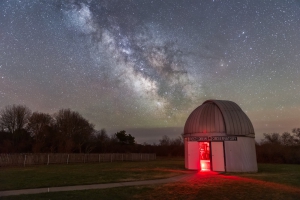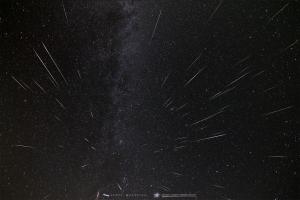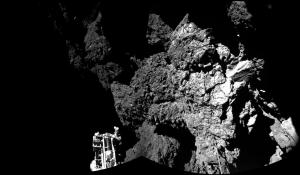
Summer Stargazing Nights
- Where:
- Frosty Drew Observatory
- When:
- Friday July 29, 2016 at 7:30 p.m.
- Cost:
- $1 Suggested Donation per Person
Tonight is Stargazing Night at Frosty Drew Observatory and again, forecasts are as reliable as a solar powered flashlight. We can potentially expect clouds, rain, fog, or clearer skies with a high degree of variability at this point. I think it’s time we accept that 2016 Friday night forecasts will be known on Saturday mornings. Our best guess expectation for tonight weather is partly cloudy to mostly clear skies with light fog. This is rather unfortunate because the 13% waning crescent Moon does not rise until 2:32 a.m. Add in that we are seeing a large increase in the number of visible meteors streaking by, three ISS passes, two Iridium Flares (one super bright!) - all alongside fabulous views of the Milky Way, and it would have been a stunning night out under the stars. It may still be.
We will open the Observatory, Sky Theatre, and Nature Center at 7:30 p.m. In the Observatory, telescopes will be on standby as we monitor sky conditions on site. If clear enough, we will start with dusk views of Jupiter and the four Galilean Moons. After which, we will direct the big telescope towards Saturn, showcasing the fabulous rings and up to five moons. As twilight wanes and the Milky Way blazes into view, we will direct our telescopes towards many of the fabulous star forming nebulae and star clusters along the galactic plane. We can also expect a notable uptick in visible meteors tonight compliments of the Perseid and June Scutid meteor showers. The Sky Theatre will feature a commentary and showcase of celestial objects photographed at Frosty Drew Observatory. Weather will decide when we close up tonight. If cloudy we will pack it in around 10:00 p.m., otherwise we will stretch it out and revel in the fabulous starscape.
Overall, the variable forecast at this point is making it tough to call what the skies will offer. Though tonight is the night to check out the Milky Way at Frosty Drew if skies are clear enough. Last week we had quite a variable forecast and it totally worked to our favor, maybe tonight will be a repeat? We will post updates to our Twitter (@FrostyDrewOBSY) and Facebook on what is happening at the Observatory with a “Closing up” post when we decide to pack it in. So blast some hope our way for clear skies and celebrate fabulous views of the cosmos with us tonight at Frosty Drew.
-------------------------------------------------------------------------
Weekly Happenings
Scott MacNeill
This past Monday, July 25th, the International Space Station (ISS) has returned to the evening sky over much of the United States. We can expect fabulous night passes of the ISS on a daily basis until August 16th. Due to the highly inclined orbit of the ISS (51° inclined to Earth’s equator) and the fact that it needs to be in direct sunlight with Earth-bound observers under darkness, we see the ISS in periods – sometimes in the morning, evening, both, or not at all. Read up on the ISS, then head over to Nasas Spot the Station and find out what time to catch fabulous sightings of the ISS over your location.
The fabulous Perseid Meteor Shower began on July 17th and is really starting to pick up. The shower peak period happens over August 11-13 with meteor activity progressively increasing as the peak approaches. We have noticed a substantial increase in visible meteors on a nightly basis over Frosty Drew Observatory, some from the Perseid shower and others from the, relatively unheard of, June Scutid shower. This year we can expect an increase in meteor rates during the peak, boosting the 80-100 meteor per hour rate to near 200 meteors per hour due to Earth passing through a dense stream of the debris field. Frosty Drew Observatory will open numerous nights for the shower peak with awesomeness in mind. Now is the time to gear up and make plans, so read up on the Perseid shower, then check out our Perseid event schedule
Remember that amazing little spacecraft that landed on a comet? The spacecraft is Philae and the comet is 67P/Churyumov-Gerasimenko, which is part of the European Space Agency (ESA) Rosetta mission. The mission, which has been massively successful, included a small lander named Philae that deployed on November 12, 2014. The historic landing attempt went awry when Philae’s anchoring harpoons failed to fire causing the little spacecraft to bounce along the comet, missing its planned landing site. The final resting place of Philae did not offer the amount of sunlight needed to keep the little spacecraft awake, resulting in lost communications. After a couple brief periods of contact, the parent spacecraft, Rosetta, has disabled the Electrical Support Systems Processor Unit (ESS), which is required to communicate with Philae, essentially ending our time with the little lander. The Rosetta mission will come to an end on September 30, 2016 when the spacecraft will execute a controlled descent onto the surface of the comet. Check out all the amazing things accomplished by the fabulous Rosetta mission. Then check out the history of Philae on the little spacecraft’s Twitter. Farewell Philae, we hardly knew you.
-Scott



